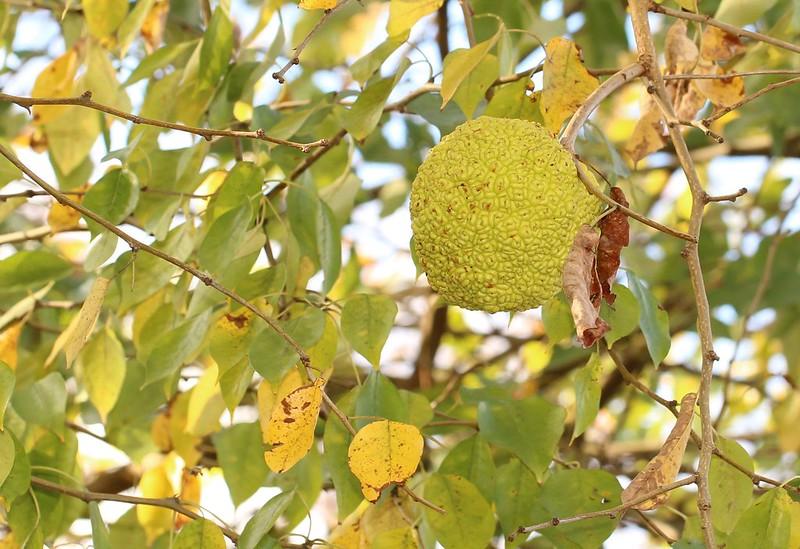From Fall 2024 issue of Branching Out. Subscribe to Branching Out here. Read more Invasives in Your Woodland articles here. This article contains information current as of date of publication.
Regular readers of this feature will note that the vast majority of species highlighted here are not native to North America. For whatever purpose, they were brought to this continent, and have since escaped from their original intent and location to be unwelcome additions to local ecosystems, affecting both plants and wildlife.
Other species, such as native grapevines, can be considered invasive if they exist in such numbers as to adversely impact the health of woodlands. This issue, however, looks at a species that is both native to North America and that has been introduced to new environments in such numbers that it is considered invasive in many areas. The species is a member of the Mulberry family called by several names, including Osage-orange, osage orange (without the hyphen), bowwood, and hedge apple. We will use the first form here, as it is not an orange tree.
Regardless of the spelling, Osage-orange (Maclura pomifera) is native to the central southern United States, from Texas to Oklahoma and Arkansas. Its dense, rot-resistant wood was used by both Native and European Americans for a variety of uses, including hunting bows and wagon wheels. Entrepreneurs started to transport the tree outside its native range for use in hedgerows (a practice still advocated by some) to the point that it escaped into new ecosystems. In Maryland, observers report it in all counties except Calvert, Worcester, and Wicomico (see below).

What is it?
Osage-orange trees are considered medium-sized, generally growing 35 to 65 feet tall. The species is dioecious, with both male and female trees. It prefers full sun but in some cases, where it has been planted as hedgerows, it can tolerate some shade. It grows vigorously if exposed to disturbed areas, such as idle agricultural areas and roadsides. The species can tolerate a wide variety of soil types, including wet and dry, and all but the most acidic soils.
How does it spread?
Historically, the greatest method of spreading Osage-orange was by humans, who intentionally transported seedlings to cultivate for use as hedgerows or windbreaks. Trees that have escaped from cultivated areas spread via seeds found in the apple-shaped fruit produced by female trees. Animals such as birds and wild animals consume the fruit and excrete the seeds.
How can I identify it?
Osage-orange trees have short trunks which split into several limbs with upward arching branches with prominent thorns. (Recent thornless male hybrids are being touted as urban street trees for their fast growth, dense wood, and resistance to deer.) The bark is deeply furrowed with a somewhat orange interior. The trees are deciduous, with simple leaves approximately 2” in length and alternate on the stem. Perhaps the easiest way to identify Osage-orange is its fruit. Each large green fruit produced by the female is the size of a baseball and ripen from September to early November. In fact, one of the easiest ways to identify Osage-orange trees in disturbed areas is to look for the fallen fruit. See the photo gallery below.
How can I control it?
The easiest way to control the spread of Osage-orange is to not plant new seedlings. Collect and dispose of fruit that has fallen to reduce the spread by animals. Selectively removing male trees can reduce the spread, as female trees will not receive windblown pollen for fertilization; the resulting fruit will be seedless.
For more information:
Learn more about Osage-orange:
Maclura pomifera (North Carolina Extension Gardener)
Osage-Orange (USDA Forest Service)
Osage Orange Maclura pomifera (Maryland Biodiversity Project)
